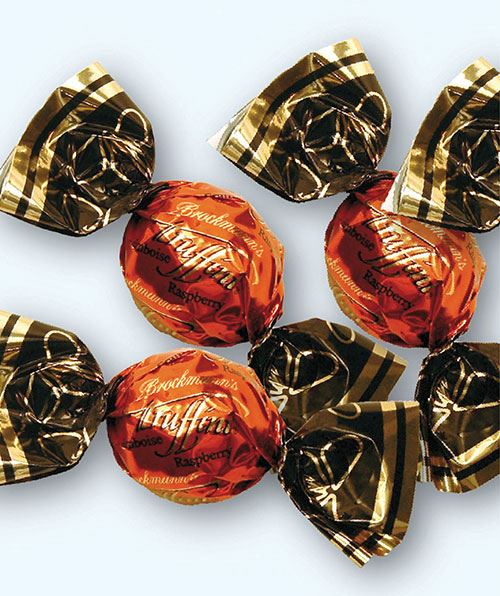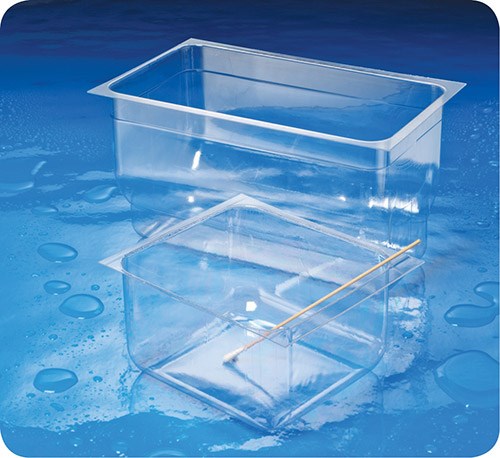Add a Layer of COC to Boost Polyolefin Film Properties
As a discrete layer in coextruded polyolefin film, cyclic olefin copolymer provides higher modulus, greater heat resistance, improved thermoformability, and increased barrier
Cyclic olefin copolymer (COC) is an amorphous thermoplastic that enables higher performance in multilayer polyolefin packaging films for medical, consumer, and industrial markets. As a discrete layer in coextruded polyolefin film, COC provides higher modulus, greater heat resistance, improved thermoformability, and increased barrier for bags, pouches, and thermoformed articles such as trays without the need for adhesive tie layers.
These multilayer films are easily processed on conventional cast and blown film lines within standard polyolefin operating parameters and can be reprocessed easily. A previous article discussed the benefits of blending COC into polyolefin film resins. This article focuses on the utilization of discrete layers of COC in multilayer structures.
VERSATILE FILM RESIN
Topas COC is based on the polymerization of ethylene and norbornene using metallocene catalysts. This material can have a glass-transition temperature (Tg) ranging from 33 C to 180 C, depending on comonomer ratio. As an amorphous polymer, COC does not have a crystalline melting point and instead softens above the Tg, becoming increasingly fluid as temperature is increased.
This colorless, crystal-clear resin offers strong compatibility with polyethylene. Its compatibility is greatest with highly linear PEs such as LLDPE but is acceptable for use with LDPE and HDPE.
COC can be diluted with around 10% LLDPE without significantly compromising performance for most application needs. COC grades most commonly extruded into film and used in multilayer structures are Topas 9506F-04 (Tg: 68 C) and Topas 8007F-400 (Tg: 78 C). Higher-Tg grades are sometimes used for special products or to enhance film heat resistance.
With a modulus in the 300,000 psi range and a glossy, hard surface, COC can be used to design polyolefin films to meet a number of design challenges, such as a “drop-in” replacement for cellophane film in twist-wrap candy packaging. The ability to provide stiffness, dead-fold, clarity, and high gloss is a major accomplishment for a coextruded, non-oriented film.
A twist-wrap film composed of COC/LLDPE/COC (20%/ 60%/20%) leverages the modulus of COC by placing it in the outer film layers, thus generating an I-beam type stiffening effect. This construction delivers excellent dead-fold and cuttability an attractive glossy surface for printing or metalizing. And unlike BOPP (another cellophane substitute), this film runs exceptionally well on twist-wrap machinery designed for cellophane.
The prior article on COC/LLDPE blends (see Learn More above right) noted how such films enhanced modulus/stiffness and thermoforming uniformity. These improvements allow a better thermoformed product to be produced using a thinner film. Recent research shows that using COC in a discrete layer provides all the same benefits even more effectively—for example, a film with 15% COC in a discrete layer outperformed a monolayer blend film containing 20% COC.
COC/LLDPE multilayer films have improved formability, optics, toughness, and puncture resistance vs. similar EVA/ionomer coextruded films at a comparable cost basis. Engineered COC/LLDPE multilayer films can also compare favorably with many nylon-based structures while eliminating the need for adhesive tie layers. Removing tie layers and non-olefin resins simplifies production logistics and permits the use of recycled scrap film because of the compatibility between COC and polyethylene.
COC is distinguished by its moisture barrier, which is four to five times better than LDPE. While COC can enhance barrier performance as a blend component, the best barrier improvement is realized when COC is utilized in a discrete layer. COC is also an excellent barrier for many other polar solvents, such as the alcohols in hand sanitizers and antiseptic sponges. COC offers 35 times better barrier to ethanol than LLDPE. Such applications typically use high-COC-content blends in coextruded films sandwiched by outer layers of LLDPE (again without a tie layer).
COC also typically provides five to 10 times better barrier resistance to aromas and fragrances than LLDPE. Although COC does not offer high oxygen or carbon dioxide barrier, its performance is still significantly better than polyethylene and can be used to tailor permeation to meet the specific gas barrier required in fresh produce packaging.
(Incidentally, COC is a good coextrusion partner with more than just polyolefins. A COC layer combined with PETG layers—tie layer required—produces a high-clarity film used for deep-draw barrier trays for medical and other applications. Other high-moisture-barrier films such as polychlorotrifluoroethylene (PCTFE) do not perform well in deep-draw applications, and halogenated polymers have special processing requirements and environmental concerns.)
As an amorphous polymer, COC has an inherently high shrink potential and a low shrinkage force. This, combined with excellent optics, tailorable shrink-initiation temperatures (determined by Tg), and a low density—which promotes good area yield and recycling, has produced a winning combination in shrink sleeves, machine-direction shrink labels, and general-purpose shrink film.
COC skin layers produce a film with high bending stiffness and good aesthetics that is still easy to handle when downgauged in a sleeve application process. Alternatively, a COC core layer enhances shrinkage performance in combination with skin polymers that are chosen for low density and cost-effectiveness. COC-based shrink films are commercially available as transverse-oriented (TDO) film for sleeves, machine-direction oriented (MDO) film for labels, and biaxially-oriented films for high-performance shrink packaging and bundling.
PROCESSING CHARACTERISTICS
COC has been extruded as a discrete layer on a variety of commercial cast and blown film lines. Processing conditions are highly similar to other polyolefins . Specific processing recommendations for each grade are available on the Topas website.
An extruder L/D of at least 24:1 and a low-compression screw design are recommended. Barrier mixing screws work very well and Maddock-type mixing sections have proven effective but are not required. Typical coat-hanger cast film dies and spiral blown film dies are acceptable.
Recommended extruder screw speed is at least 50 rpm. If lower speeds must be used to accommodate throughput requirements, mixing can be increased by generating a higher extruder discharge pressure (>2000 psi) through the use of a tighter screen pack.
Extrusion temperature settings typically depend on the Tg of the COC. Most commonly, settings are 130° to 150 °C above the Tg. The aggressive feeding of grooved-feed-throat extruders (as are commonly used in Europe) poses a challenge for extruding hard, high-modulus polymers such as COC, because fines generated in the feed can produce unmelts that appear as gels. Grooved-feed extruders should be run with a hot (120 C) feed zone and preferably use a grade that has been specifically formulated for grooved feeds, such as Topas 8007F-400.
Other cast and blown film extrusion parameters are in line with those used for conventional PE. In blown film, the increased stiffness produced by high COC levels can cause challenges in achieving wrinkle-free bubble collapsing and layflat. In general, keeping the film warmer in the collapsing section will help. Equipment designed to handle stiff films of HDPE and nylon will typically produce better results when producing stiff films with high COC content.
Topas COC is a thermally stable resin and resistant to the formation of gels, however, it may be desirable to purge COC from equipment for transitions or shutdowns. A typical purge may consist of 50% 1-MI LLDPE and 50% of a standard PE purge compound.
Most TOPAS COC grades comply with all major regulatory food-contact requirements and are also approved for use in medical and pharmaceutical applications.
Related Content
Recycled Material Prices Show Stability Heading into 2023
After summer's steep drop, most prices leveled off in the second half.
Read MoreDensity & Molecular Weight in Polyethylene
This so-called 'commodity' material is actually quite complex, making selecting the right type a challenge.
Read MoreThe Fundamentals of Polyethylene – Part 2: Density and Molecular Weight
PE properties can be adjusted either by changing the molecular weight or by altering the density. While this increases the possible combinations of properties, it also requires that the specification for the material be precise.
Read MoreImproving Twin-Screw Compounding of Reinforced Polyolefins
Compounders face a number of processing challenges when incorporating a high loading of low-bulk-density mineral filler into polyolefins. Here are some possible solutions.
Read MoreRead Next
Cyclic Olefin Copolymer Enhances Polyolefin Blends for Film Packaging
Cyclic olefin copolymer (COC ) is an amorphous thermoplastic that is finding increased utility as a blending agent in polyolefin packaging films for medical, consumer, and industrial markets.
Read MoreHow Polymer Melts in Single-Screw Extruders
Understanding how polymer melts in a single-screw extruder could help you optimize your screw design to eliminate defect-causing solid polymer fragments.
Read More



















.png;maxWidth=300;quality=90)









